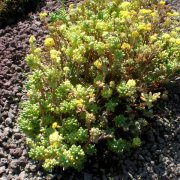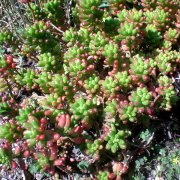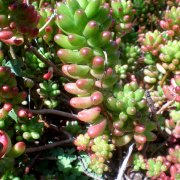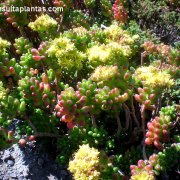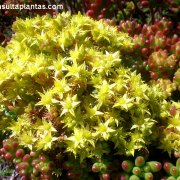Care of the succulent plant Sedum rubrotinctum or Jelly bean plant |
|
The genus Sedum, family Crassulaceae, comprises 350 species of succulent plants distributed in cold and temperate regions of almost the entire planet. Some species are: Sedum rubrotinctum, Sedum palmeri, Sedum pachyphyllum, Sedum morganianum, Sedum dendroideum, Sedum confusum, Sedum album, Sedum moranense, Sedum clavatum, Sedum acre, Sedum sieboldii, Sedum dasyphyllum, Sedum spurium, Sedum spectabile. Common names: Jelly bean plant, Pork and beans. This species is native to Mexico. They are small succulent plants with a creeping bearing that reach 20 cm (7.87") in height. They have fleshy, cylindrical, light green leaves with reddish tips if they receive adequate light. They produce inflorescences with abundant yellow flowers. They bloom during the spring. Jelly bean plant is used in rockeries, in succulent gardens and in pots and planters for terraces, balconies or as indoor and greenhouse plants. Sedum rubrotinctum needs full sun exposure but can grow in semi-construction (the leaves will be green and not reddish). The soil can be a mixture, in equal parts, of normal garden soil, coarse sand, and leaf mulch. Water regularly in summer waiting for the soil to dry out; reduce watering the rest of the year and water very little in winter. Fertilize with low concentration mineral fertilizer monthly during spring and summer. Pork and beans does not need pruning. Sedum rubrotinctum can be attacked by fungi if there is excess watering and, sometimes, by aphids and mealybugs. Jelly bean plant is propagated by stem or leaf cuttings set to root in sand during the summer. |
Images of the succulent plant Sedum rubrotinctum or Jelly bean plant |
Find plants
Sedum rubrotinctum or Jelly bean plant | Care and Growing
© 2025 FavThemes
